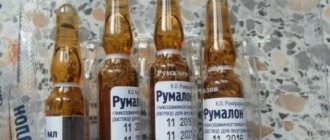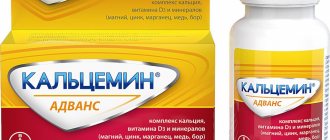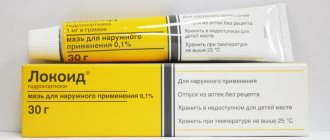Compound
Flamax capsules (1 capsule) contain the active ingredient ketoprofen (50 mg), as well as additional substances: MCC, lactose monohydrate, sodium lauryl sulfate, croscarmellose sodium, colloidal silicon dioxide, povidone.
Flamax Forte tablets contain 100 mg of the active ingredient ketoprofen (1 tablet), as well as additional ingredients: rice starch, lactose monohydrate, croscarmellose sodium, colloidal silicon dioxide, MCC, povidone, sodium lauryl sulfate, macrogol 6000, magnesium stearate, hypromellose, talc, titanium dioxide
Flamax in the form of a solution in one ampoule (2 ml) contains 100 mg of ketoprofen . The composition also includes additional substances propylene glycol, benzyl alcohol, ethanol, sodium hydroxide, water for injection.
Release form
Flamax is available in the form of capsules, a solution for intravenous and intramuscular administration, rectal suppositories, lyophilisate for subsequent preparation of the solution, tablets, capsules.
Flamax capsules have a white body and a blue cap; inside there is a white powder that has a uniform consistency.
The solution is contained in 2 ml ampoules with a colored break ring or notch. The blister pack contains 5 ampoules.
Flamax Forte is available in the form of biconvex round blue tablets, which are film-coated. The blister contains 10 tablets, 2 blisters are placed in a cardboard box.
Flamax Forte capsules are contained in a plastic container, which is placed in a cardboard pack.
Pharmacodynamics and pharmacokinetics
Ketoprofen binds to blood proteins in the body by 99%, mainly to albumin. The highest concentration of the substance in plasma is achieved relatively quickly. Ketoprofen quickly penetrates into connective tissue and synovial fluid. 15 minutes after a single injection of the drug intramuscularly, a high concentration of the active substance is observed in the synovial fluid. It lasts up to 30 hours, so it is possible to reduce pain and stiffness in the joints for a long period of time. It does not penetrate the BBB in significant quantities.
Metabolism of ketoprofen occurs mainly in the liver. There the glucuronidation process takes place, after which esters and glucuronic acid are formed. They are then excreted by the kidneys. The half-life of ketoprofen ranges from 1.6 to 1.9 hours.
Indications for use
The medicine Flamax and Flamax Forte are used for the symptomatic treatment of pain and inflammatory processes of various origins at moderate intensity:
- diseases of the human musculoskeletal system ( arthritis , rheumatic soft tissue lesions , ankylosing spondylitis , osteoarthritis );
- sciatica , neuralgia , lumbago ;
- migraine , pain after surgery;
- painful menstruation , inflammatory processes in the pelvic organs;
- pain and inflammation after injuries;
- toothache;
- pain due to cancer.
Contraindications
Flamax is not used in the following cases:
- high sensitivity;
- period of exacerbation of ulcers and erosions of the gastrointestinal tract;
- exacerbation of inflammatory bowel diseases;
- bleeding from the gastrointestinal tract;
- acute period of kidney disease, severe form of liver failure.
- hyperkalemia;
- progressive kidney disease;
- a combination of recurrent nasal polyposis or bronchial asthma with intolerance to NSAIDs, in particular acetylsalicylic acid;
- disorders of hemostasis , hematopoiesis ;
- after coronary artery bypass surgery ;
- third trimester of pregnancy and breastfeeding;
- The patient's age is up to 15 years.
The medicine is used with caution for arterial hypertension , bronchial asthma , edema, chronic heart failure , sepsis , diabetes mellitus , renal failure , coronary artery disease, and severe somatic diseases.
Contraindications to drug treatment
The use of different medicinal variants of Flamax is impossible in some patients due to the presence of strict contraindications. The described medication is not prescribed if the patient is diagnosed with:
- erosive and ulcerative lesions of the digestive system in the acute period;
- bleeding from the gastrointestinal tract, inflammation of the intestines;
- renal failure;
- violations of the basic functions of the liver and diseases of this organ;
- progressive pathologies of the renal system;
- excess potassium in the body;
- abnormalities in the functioning of the hematopoietic organs, hemostasis, hemophilia;
- postoperative period after coronary artery bypass surgery;
- problems with the urinary system;
- lactation period, last trimester of pregnancy;
- children under 14 years of age;
- individual excessive sensitivity to the components of the drug or intolerance to them.
The use of Flamax is not recommended if there is a history of intolerance to other NSAID drugs. A previously developed allergic reaction to such drugs is also a contraindication.
Ketoprofen therapy is prescribed with caution for bronchial asthma, chronic cardiac failure, and arterial hypertension. Treatment should be carried out under the supervision of doctors if the patient is diagnosed with diabetes mellitus and ischemia. When prescribing the drug to patients with impaired renal function or patients over 65 years of age, a mandatory adjustment of the daily dose is required.
Side effects
The following side effects may occur:
- Digestive system: dyspepsia , abdominal pain, changes in taste, liver dysfunction, stomatitis, changes in taste. With prolonged treatment with large doses of drugs, bleeding of the gastrointestinal tract, gums, and the appearance of ulcers on the gastrointestinal mucosa is possible.
- Nervous system: insomnia , headache , nervousness, dizziness , migraine, symptoms of drowsiness or increased excitability, memory impairment.
- Sense organs: blurred vision, ringing in the ears, pain and dry eyes, hearing loss, conjunctival hyperemia .
- Cardiovascular system: tachycardia , increased blood pressure.
- Hematopoietic organs: anemia , agranulocytosis , leukopenia , thrombocytopenia .
- Urinary system: cystitis , urethritis , renal dysfunction, nephritis , hematuria .
- Allergic manifestations: rash, itching of the skin, swelling, rhinitis , bronchospasm , dermatitis .
- Other manifestations: hemoptysis , severe sweating, muscle twitching, shortness of breath, myalgia, nosebleeds. When treated with large doses of the drug, vaginal bleeding is possible.
Negative phenomena that develop while taking
Flemax based on ketoprofen is generally well tolerated by different groups of patients. However, during therapy, unwanted side effects may occur. If unpleasant symptoms intensify, you must stop taking the drug and contact a medical facility to replace it or adjust the dose. Treatment with Flamax may be accompanied by the following symptoms:
WE RECOMMEND THE ARTICLE!
Nurofen is effective for rheumatism, radiculitis, neuralgia, sprains, bruises and other injuries. Read more >>
- Disorders of the hematopoietic organs
. The development of anemia, including hemolytic, leukopenia, and agranulocytosis is possible. - Functional abnormalities of the nervous system
. During course therapy with ketoprofen, dizziness, nervous, and asthenic conditions may occur. Sometimes memory impairment and confusion of thoughts are recorded, and there is a risk of developing depressive disorders. - Digestive system
. There is a possibility of developing dyspeptic pain, vomiting, and nausea. Treatment may be accompanied by diarrhea, excessive flatulence, and increased acidity. There may be a change in taste sensations. - Urinary organs
. During therapy, the occurrence of disorders of the genitourinary system cannot be ruled out. The risk of developing cystitis, nephritis and other abnormalities in kidney function increases. - The cardiovascular system
. Taking the drug is sometimes accompanied by tachycardia and surges in blood pressure. If such symptoms intensify, continuation of treatment is impossible without dosage adjustment.
The risk of an allergic reaction cannot be excluded. It can be expressed as a reddish rash, itching, and swelling. Allergic bronchospasms, Quincke's edema, and anaphylactic shock were rarely recorded during the use of Flamax.
Instructions for use of Flamax (Method and dosage)
If a patient begins treatment with Flamax, the instructions for use should be carefully studied.
Injections (solution) are administered intravenously and intramuscularly. Intravenous administration is carried out exclusively in a hospital. On average, the infusion lasts 0.5–1 hour, maximum 48 hours. The dose of the medicine should not be higher than 300 mg. For a short infusion, 100–200 mg of the drug is diluted in 100 ml of 0.9% sodium chloride solution, the administration lasts no more than 1 hour. The next time the drug can be administered after 8 hours. For continuous infusion, 100–200 mg of the drug is diluted in 500 ml of solution for infusion, the administration lasts 8 hours. The next time you can administer the drug after 8 hours.
Flamax is administered intramuscularly at 100 mg 1–2 times a day.
Flamax capsules should be taken orally during meals. The dosage is prescribed by the doctor depending on the course of the disease. The maximum dose per day is 300 mg.
Instructions for use of Flamax Forte stipulate that the tablets should be taken orally during meals. As a rule, 1 tablet is prescribed 2-3 times a day. The permissible daily dose is 300 mg.
Flamax forte
Trade name: Flamax forte International name: Ketoprofen&, (Ketoprofen)
Pharmacological group: NSAID (non-steroidal anti-inflammatory drug) Pharmacological group for ATC: M01AE03. Ketoprofen Pharmacodynamics: NSAID, has anti-inflammatory, analgesic and antipyretic effects associated with suppression of the activity of COX1 and COX2, which regulate the synthesis of Pg. The anti-inflammatory effect occurs by the end of 1 week of use.
Pharmacokinetics: Absorption is rapid, bioavailability is more than 90%. Communication with plasma proteins - 99%. TCmax - 1-2 hours after oral administration, 1.4-4 hours - with rectal administration, 15-30 minutes - with parenteral administration. When taking retard tablets, the minimum effective concentration is determined after 45-60 minutes. Css in plasma is achieved 24 hours after the start of regular use. The therapeutic concentration in the synovial fluid lasts 6-8 hours. It does not penetrate the BBB in a significant amount. It is almost completely metabolized in the liver by glucuronidation and has a “first pass” effect through the liver. Excreted by the kidneys (mainly) and intestines (1%). T1/2 - 1.6-1.9 hours - for regular tablets and 5.4 hours - for extended-release tablets. Does not accumulate.
Indications for use: Inflammatory and degenerative diseases of the musculoskeletal system: rheumatoid, psoriatic arthritis, ankylosing spondylitis (ankylosing spondylitis), gouty arthritis (in case of an acute attack of gout, fast-acting dosage forms are preferred), osteoarthritis. Intended for symptomatic therapy, reducing pain and inflammation at the time of use, does not affect the progression of the disease. Pain syndrome: myalgia, ossalgia, neuralgia, tendonitis, arthralgia, bursitis, radiculitis, adnexitis, otitis media, headache and toothache, in cancer, post-traumatic and postoperative pain syndrome accompanied by inflammation. Algodysmenorrhea, childbirth (as an analgesic and tocolytic agent).
Contraindications: Hypersensitivity (including to other NSAIDs), a history of bronchial asthma, rhinitis or urticaria caused by taking ASA or other NSAIDs, gastric and duodenal ulcers (exacerbation), ulcerative colitis (exacerbation), Crohn's disease, diverticulitis, peptic ulcer, hemophilia and other coagulation disorders, active gastrointestinal bleeding, severe renal failure (creatinine clearance less than 30 ml/min), progressive kidney disease, severe liver failure or active liver disease, condition after aortocoronary bypass surgery, confirmed hyperkalemia, inflammatory bowel diseases, children (up to 6 years), pregnancy (III trimester).
With caution: Anemia, bronchial asthma, alcoholism, tobacco smoking, alcoholic cirrhosis of the liver, hyperbilirubinemia, liver failure, dehydration, sepsis, CHF, edema, arterial hypertension, blood diseases (including leukopenia), stomatitis, ischemic heart disease, cerebrovascular diseases, dyslipidemia/hyperlipidemia, diabetes mellitus, peripheral arterial disease, chronic renal failure (creatinine clearance 30-60 ml/min), a history of ulcerative lesions of the gastrointestinal tract, the presence of Helicobacter pylori infection, long-term use of NSAIDs, severe somatic diseases, simultaneous use of oral corticosteroids (including . prednisolone), anticoagulants (including warfarin), antiplatelet agents (including clopidogrel), selective serotonin reuptake inhibitors (including citalopram, fluoxetine, paroxetine, sertraline), old age, pregnancy (I , II trimester), lactation period.
Dosage regimen: Inside, intramuscularly, intravenously.
Tablets, drops for oral administration - 100 mg 3 times a day or 150 mg / day (retard) with an interval of 12 hours. Capsules - 50 mg in the morning and afternoon, 100 mg in the evening. The combined use of dosage forms is possible.
IM - 100 mg 1-2 times a day. IV, drip - 100-200 mg in 100-500 ml of 0.9% NaCl solution. Infusions are carried out only in a hospital, no more than 300 mg over 0.5-1 hour.
Side effects: From the digestive system: NSAID gastropathy, abdominal pain, dyspepsia (nausea, vomiting, heartburn, flatulence, loss of appetite, diarrhea), stomatitis, impaired liver function, rarely - change in taste. With long-term use in large doses - ulceration of the gastrointestinal mucosa, gingival, gastrointestinal, and hemorrhoidal bleeding. From the nervous system: headache, dizziness, insomnia, agitation, nervousness, drowsiness, depression, asthenia, rarely - confusion or loss of consciousness, forgetfulness, migraine, peripheral neuropathy. From the senses: noise or ringing in the ears, blurred vision, rarely - conjunctivitis, dry mucous membrane of the eye, pain in the eyes, conjunctival hyperemia, hearing loss, vertigo. From the cardiovascular system: increased blood pressure, rarely - tachycardia. From the hematopoietic organs: rarely - agranulocytosis, anemia, hemolytic anemia, thrombocytopenia, leukopenia. From the urinary system: edematous syndrome, rarely - cystitis, urethritis, impaired renal function, interstitial nephritis, nephrotic syndrome, rarely - hematuria. Allergic reactions: skin rash (including erythematous, urticaria), skin itching, rhinitis, angioedema, rarely - bronchospasm, exfoliative dermatitis, anaphylactic shock. Other: increased sweating, rarely - hemoptysis, nosebleeds, myalgia, muscle twitching, shortness of breath, thirst, photosensitivity, with prolonged use in large doses - vaginal bleeding. The lysine salt of ketoprofen in comparison with ketoprofen (due to its neutral reaction and less local irritant effect on the gastrointestinal mucosa) is less likely to cause side effects from the gastrointestinal tract.
Interaction: Pharmaceutically incompatible with tramadol solution. Reduces the effectiveness of uricosuric drugs, enhances the effect of anticoagulants, antiplatelet agents, fibrinolytics, ethanol, side effects of GCS and MCS, estrogens, reduces the effectiveness of antihypertensive drugs and diuretics. Combined use with other NSAIDs, corticosteroids, ethanol, corticotropin can lead to the formation of ulcers and the development of gastrointestinal bleeding, increasing the risk of developing renal dysfunction. Co-administration with oral anticoagulants, heparin, thrombolytics, antiplatelet agents, cefaperazone, cefamandole and cefotetan increases the risk of bleeding. Increases the hypoglycemic effect of insulin and oral hypoglycemic drugs (dose recalculation is necessary). Inducers of microsomal liver enzymes (phenytoin, ethanol, barbiturates, rifampicin, phenylbutazone, tricyclic antidepressants) increase the production of hydroxylated active metabolites. Co-administration with valproic acid causes disruption of platelet aggregation. Increases plasma concentrations of verapamil and nifedipine, Li+ drugs, methotrexate. Antacids and cholestyramine reduce absorption. Myelotoxic drugs increase the manifestations of hematotoxicity of the drug.
Special instructions: During treatment, it is necessary to monitor the peripheral blood picture and the functional state of the liver and kidneys. If it is necessary to determine 17-ketosteroids, the drug should be discontinued 48 hours before the study. Taking ketoprofen can mask the signs of an infectious disease. If renal or liver function is impaired, dose reduction and careful monitoring are necessary. During the treatment period, care must be taken when driving vehicles and engaging in other potentially hazardous activities that require increased concentration and speed of psychomotor reactions. To reduce the risk of developing adverse events from the gastrointestinal tract, the minimum effective dose should be used for the shortest possible short course.
Manufacturer: Replek Pharm LLC Skopje, Macedonia Registration certificate holder: Sotex PharmFirma CJSC, Russia Release form: film-coated tablets 100 mg, blister Belongs to VED Preferential release: DLO Conditions of release: by prescription Registration data: LSR-000012 from 21.03. 2007 Status of the registration certificate: valid Pharmaceutical article number: LSR-000012-210307
Manufacturer: Replekpharm AD, Republic of Macedonia Registration certificate holder: Replekpharm AD, Republic of Macedonia Release form: film-coated tablets 100 mg, contour cell packaging Belongs to VED Preferential release: DLO Conditions of release: by prescription Registration data: LSR-000012 from 21.03 .2007 Status of the registration certificate: valid Pharmaceutical article number: ND 42-14591-06
Interaction
When treating any other drugs together with Flamax, you should always consult your doctor before starting therapy.
If Flamax and loop diuretics , the nephrotoxic effect of these drugs increases. Flamax reduces the effectiveness of uricosuric drugs, but increases the effect of anticoagulants , ethanol , fibrinolytics , antiplatelet agents , as well as the manifestation of side effects when taking corticosteroids and mineralocorticosteroids , estrogens .
Flamax reduces the effectiveness of antihypertensive drugs and diuretics.
When used simultaneously with GCS , other NSAIDs , corticotropin , ethanol , gastrointestinal bleeding, ulcers, and renal dysfunction may occur.
The risk of bleeding increases when taken simultaneously with heparin , anticoagulants , thrombolytics , antiplatelet agents , cefoperazone , cefamandole , cefotetan .
When treating with Flamax, the doses of insulin and other hypoglycemic drugs should be recalculated, since their hypoglycemic effect increases.
Concomitant treatment with sodium valproate leads to a decrease in platelet aggregation.
Increases the concentration of Nifedipine , verapamil , lithium preparations, methotrexate in the blood plasma.
Increases the hematotoxicity of myelotoxic drugs.
Absorption of the drug is reduced when taking cholestyramine and antacids simultaneously.
When Tramadol and Flamax are mixed in one bottle, a sediment forms.
Drug overdose
There are no data on the occurrence of overdose during the treatment of Flamax drugs. With long-term use in high doses, increased side effects are likely. If you accidentally swallow a large number of capsules, induce vomiting, rinse your stomach, and then contact a medical facility.
In hospital settings, if an overdose is suspected, gastric lavage is also performed and symptomatic therapy is prescribed. No specific antidotes have been developed for the drug.
special instructions
If treatment with Flamax and Warfarin or lithium preparations , strict monitoring by the attending physician is necessary.
Flamax can mask signs of infectious diseases.
During therapy, it is important to monitor peripheral blood parameters, as well as the activity of the liver and kidneys. If their functions are impaired, the dose should be reduced and the patient should be closely monitored.
To reduce the likelihood of developing side effects from the gastrointestinal tract, you need to use minimal doses of the drug and not practice long-term treatment.
If 17-ketosteroids , Flamax is canceled 48 hours before the test.
It is important to consider that concentration may deteriorate during treatment with the drug, so you should drive carefully and perform other potentially dangerous work.
Reviews from patients and doctors
The opinions of patients and doctors about the use of the drug are different, but in most cases they are positive. One of the advantages of such products is their gentle effect on the gastrointestinal tract. The use of Flamax for pain relief is indicated even if there is a history of stomach or intestinal pathology. However, in this case you need to carefully choose the dosage.
The drug should not be used for more than 3 days in accordance with the instructions without consulting a doctor.
The described drug can be used in complex therapy of diseases of the joints and spine as an analgesic and anti-inflammatory agent. It quickly reduces the severity of pain and helps with inflammation. In rare cases, it is possible to prescribe a drug to reduce fever.
Analogs
Level 4 ATC code matches:
Artrum
Brustan
Ketonal Duo
Nurofen Plus
Nurofen Express
Nurofen Forte
Nurofen Express Lady
Nurofen for children
Nurofen
Ibuprom
Ibuprofen
Advil
MIG 400
Has
Ketoprofen
Vimovo
Naproxen
Flexen
Nalgesin
Novigan
Analogs of Flamax and Flamax Forte, which are sold in pharmacies, are the drugs Ketonal , Flexen , Artrosilene , Ketospray , Ketonal uno , Arketal , Artrum , Profenid , etc.
All analogues have the same effect on the body as Flamax, but the decision on the final choice of drug should be made only by a doctor.
Analogs of the drug Flamax
Since the described drug has many contraindications, in some cases, when treating a patient, a change in drug is required. Modern pharmaceutical companies offer a wide range of medications that have a similar effect on the body. Most often, instead of Flamax, patients are prescribed the following analogues:
| № | Name of the product | Active ingredient | Manufacturer | How much does it cost in rubles |
| 1 | Ketonal | ketoprofen | Lek d.d., Ljubljana, Slovenia | 100-150 |
| 2 | Mydocalm | tolperisone hydrochloride | JSC "Gedeon Richter", Hungary | 380-450 |
| 3 | Artrum | ketoprofen | BIOSINTEZ JSC, Russia | 180-220 |
| 4 | Combilipen | vitamins B1, B12, B6 | PHARMSTANDARD-UfaVITA JSC, Russia | 150-170 |
Flamax price, where to buy
The price of Flamax ampoules is on average 120 rubles. per pack 5 pcs. The cost of capsules is 100-120 rubles. per pack 25 pcs. The price of Flamax Forte is 120-150 rubles. (tablets in a package of 20 pcs.).
- Online pharmacies in RussiaRussia
ZdravCity
- Flamax solution for intravenous and intramuscular injection.
50 mg/ml 2 ml 5 pcs. CJSC “Pharm” 122 rub. order - Flamax capsules 50 mg 25 pcs. Replek Pharm LLC Skopje/ZAO PharmFirma Sotex
114 RUR order
- Flamax solution for intravenous and intramuscular injection. 50mg/ml 2ml 10 pcs. JSC "Pharm"
250 rub. order
- Flamax Forte tablets p.p.o. 100 mg 20 pcs. Replek Pharm LLC Skopje / JSC PharmFirma Sotex
119 RUR order










